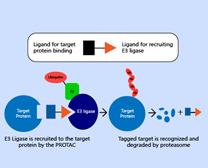Revolutionizing Cancer Treatment: Unveiling the Promising Applications of PROTACs
In the dynamic landscape of cancer research and treatment, innovative approaches are continually sought to enhance the efficacy of therapies and overcome challenges like drug resistance. Proteolysis-Targeting Chimeras (PROTACs) have emerged as a groundbreaking technology with promising applications in the realm of cancer treatment and research.
Precision Oncology: Targeting Specific Proteins
PROTACs operate by inducing the degradation of specific proteins implicated in cancer progression. This precision targeting allows for tailored therapies, minimizing collateral damage to healthy cells.
Overcoming Resistance: A Game-Changer in Cancer Therapy
One of the notable challenges in cancer treatment is the development of drug resistance. PROTACs offer a novel strategy by degrading proteins responsible for resistance, potentially circumventing this common hurdle.
Expanding Therapeutic Targets: Beyond Conventional Approaches
Unlike traditional cancer treatments that focus on inhibiting proteins, PROTACs open new possibilities by facilitating the degradation of target proteins. This expanded target range broadens the scope for therapeutic interventions.
Combination Therapies: Synergizing with Existing Treatments
PROTACs have the potential to synergize with existing cancer therapies, creating opportunities for combination treatments. This approach may lead to enhanced treatment outcomes and reduced side effects.
Additional reading:
What is Chloroacetyl chloride used for?
Boost Your Phenol Alkylation Plant's Efficiency with Steric Considerations
The Global Impact of Praziquantel: Fighting Neglected Tropical Diseases
Exploring Fascinating Riboflavin Facts
The Versatile World of Polypropylene Fibers
What is the graphite electrode used for?
Does Ivermectin kill fleas?PROTACs in Hematological Malignancies: A New Hope
The adaptability of PROTAC technology allows researchers to explore its effectiveness in hematological cancers, offering a new avenue for developing therapies against diseases like leukemia and lymphoma.
Reducing Side Effects: Towards More Tolerable Treatments
By precisely targeting cancer-related proteins, PROTACs may contribute to reducing the side effects commonly associated with traditional chemotherapy, providing patients with more tolerable treatment options.
PROTAC Clinical Trials: Progress and Prospects
Investigate ongoing clinical trials involving PROTACs, highlighting the progress made and the potential impact on cancer patients. This section can provide readers with insights into the current state of research and future expectations.
Challenges and Future Directions: Navigating the Road Ahead
Acknowledge the challenges that still need to be addressed in the development and implementation of PROTACs in cancer therapy. Discuss potential solutions and outline the future directions of this promising field.
Conclusion: In the quest for more effective and targeted cancer treatments, PROTACs stand out as a beacon of hope. Their ability to precisely degrade specific proteins associated with cancer opens up new possibilities for personalized therapies, offering a brighter future for cancer patients. As research continues to unravel the full potential of PROTACs, the oncology landscape may witness a transformative paradigm shift in the way we approach and treat cancer.
Unraveling the Applications and Significance of C3F6 Industrial Gas
5 Uses of Benzocaine
What is nano powder used for?
Exploring Diverse Processes for Producing Hydrogen Peroxide
How do you make redispersible polymer powder?
How Does art paint tools supplier Work?
What are the advantages of painting?



Comments
0